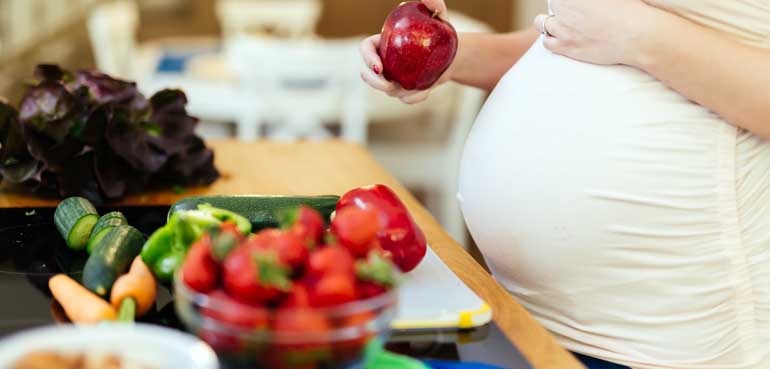If you’re pregnant or considering pregnancy in the future, you may be wondering how to get your child off to a good start. One of the best ways is by adopting a healthy diet. Research continues to highlight the importance of a healthy diet both before and during pregnancy to support a baby’s development and set kids up for healthier habits and reduced risk of disease and obesity in the future. It’s not always easy, though, especially when the sickness kicks in during the first trimester.
Pregnancy is an exciting time in a woman’s life. So many changes are happening: physical, emotional, financial and many more. One of the biggest changes – for better or for worse – can be found in the diets of newly pregnant women. If you are one of the lucky ones, your pregnancy hasn’t given rise to any aversions to healthy foods, but rather to ice cream, cakes and pies. You happily load up on lean proteins, fruits and leafy green vegetables at every meal. If, however, you are on the other end of the spectrum, you might be fighting nausea, can’t stand the smell of anything cooked, and the thought of broccoli sends you on a beeline to the bathroom. In a perfect world, your diet would be a breeze and look something like this:
- Leafy Vegetables like kale, spinach, and collard greens as well as asparagus, broccoli and other fruits and vegetables that are rich in folate, an essential nutrient involved in closing a baby’s neural tube.
- Fresh fruits and vegetables to replenish vitamin and mineral stores being used by the baby.
- Fish that is low in mercury, such as salmon and herring, to be consumed once a week for its high concentrations of docosahexaenoic acid (DHA), which is important for brain development.
- High calcium foods such as milk, fortified orange juice and yogurt to help maintain normal levels of serum calcium in mom (without having to pull the calcium from her bone).
- High-protein, iron-rich foods, such as lean beef, chicken or pork, soy products, and beans/legumes.
- No alcohol, which can lead to fetal alcohol syndrome.
- No processed lunch meats or soft unpasteurized cheeses, due to their likelihood of containing listeria monocytogenes, a bacteria that can have a negative effect on the baby as well as the mom.
- No raw or undercooked meat, fish, poultry, eggs and dairy.
- Minimum amounts of caffeine – less 200mg a day.
- Minimum amounts of canned fish – once every other week maximum
In the real world, you may need to improvise. Healthy Dining’s Vice President of Nutrition Strategy and registered dietitian Nicole Ring faced just this reality check when she was pregnant:
“Then reality (or should I say, hormones) hit me like a ton of bricks. My body, which once loved vegetables, was repulsed by the smell and taste of cooked vegetables. Broccoli, green beans, you name it! I was disgusted by them all. I also could no longer handle even the thought of eating fish…which is (kind of) a big deal, because salmon, brown rice and zucchini is my husband’s all-time favorite meal, something we consumed weekly. My ritualistic breakfast of high-fiber cereal, blueberries and 1% milk was also off my list. Actually, milk in general was off my list because I suddenly developed a case of a “grumbly tummy.” The energy I once had to make dinner every night completely disappeared, and I found myself relying exclusively on pre-packaged microwave meals and restaurant fare.”
After a few days of eating nothing but quesadillas, strawberries, and peanut butter and jelly sandwiches, Nicole came up with a couple tricks to make sure she got what she needed, so her diet would have more variety and contain more than just a few food groups.
- Smoothies – Switch over to having a smoothie loaded with fresh spinach, carrots, banana, pineapple and protein powder for breakfast along with a piece of toast. This trick gets in protein without the smell of eggs cooking along with a few servings of vegetables without having to actually taste them.
- Pasta – Sometimes vegetables are easier to eat when they’re mixed with other ingredients. Tomato sauce technically counts as a vegetable, and even better, one that can easily accommodate the addition of other veggies, such as onion, garlic, mushrooms, spinach and kale. Pasta is also fairly easy to prepare and can even be frozen for leftovers later.
- Fortified Orange Juice – While it’s usually best to opt for the whole fruit, when it comes to calcium fortification, orange juice is a great choice…especially if you can’t tolerate milk.
- Hidden Vegetables – Just like many parents do with their toddlers, try incorporating veggies and beans into foods like meatloaf, veggie burgers and mac n’ cheese. When vegetables are cooked with other ingredients at the same time, it can help minimize the strong smell.
- Soups – Look for a soup that has a vegetable base and is a source of lean protein, like beans or chicken. Soups can be soothing on the stomach and are a great way to make sure you are not missing out on important food groups. Just watch out for the sodium content, as canned soups are often high in sodium.
It might take a little more planning and thinking outside of the box, but healthy eating can be possible during your first trimester and throughout pregnancy.
What are your tricks for following a healthy diet when the nausea of pregnancy hits?
Or, you may opt to skip the cooking altogether in favor of a meal out. Menu choices like those found on Healthy Dining Finder are made with nourishing ingredients that can support you and your baby, no cooking required.

